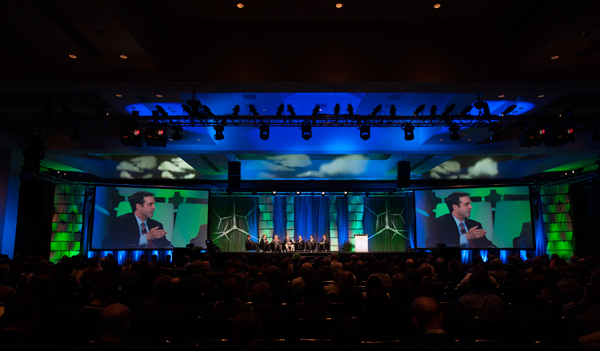The WINDPOWER 2014 Conference & Exhibition kicked into high gear today with a sharp focus on the future, as federal officials previewed an ambitious vision for the growth of U.S. wind energy to 35 percent of the grid by 2050, and industry leadership outlined four pillars for immediate expansion.
At a special afternoon Power Session, the U.S. Department of Energy (DOE) shared preliminary findings for the first time of its Wind Vision initiative, launched last year at WINDPOWER: 10 percent wind energy on the U.S. power grid by 2020, 20 percent by 2030, and 35 percent by 2050.
That will require as much growth in the next six years as the past 40. Jose Zayas, Director of the Wind and Water Power Technologies Office at DOE, said research so far suggests the benefits to America could be impressive to say the least:
- $520 billion saved for electric consumers between now and 2050, when electricity will cost 3 percent less than it otherwise would,
- 336 billion gallons of water saved by 2050, and
- 140,000 industry jobs by 2020 and 400,000 jobs by 2050, plus spinoff benefits.
The current draft of the Wind Vision suggests that approximately 10,000 MW a year would be deployed over the next several years, including substantial offshore wind starting to come online by the latter part of this decade, and major repowering of older projects starting by the mid-20s. The industry has proven it can manufacture and install more than that per year, so “we have the ability to do this,” said Zayas. “This is achievable.”
Susan Reilly, newly installed as AWEA Board Chair, agreed with Zayas that the industry can deliver on the Wind Vision, particularly because of the growing urgency over cutting carbon emissions to avert climate change. By 2050, DOE’s initial projections are that U.S. wind energy will cut 550 million metric tons of carbon dioxide per year. She said further peer review this summer is welcome and essential: “This is not a sales document. It’s got to be intellectually robust and stand up to scrutiny.”
DOE staff will share more preliminary findings on another WINDPOWER panel Thursday morning. The draft document will be circulated by June, and then peer review will continue with industry experts beyond the hundreds consulted to date. The Wind Vision will be finalized and released to the public this fall.
The morning’s Opening Session also was highly focused on the road ahead. AWEA CEO Tom Kiernan congratulated the industry for cutting the cost of American wind power an extraordinary 43 percent in just four years, while 10,000 MW of much-needed transmission has been added, with more lines under development to carry thousands more megawatts.
But, said Kiernan, “There is a lot more to do if we are going to double wind by 2020 and get 30 percent by 2030.” He reported on four pillars for future growth: driving demand through effective state and federal policies, continuing to lower costs, enhancing implementation such as by building another 60,000 MW of power line capacity, and educating political leaders.
Kiernan concluded with a call to action to make sure that policymakers know about the industry’s economic benefits—and that 72 percent of Americans favor wind power, and 73 percent support continuing tax incentives to install more of it, according to recent polls. Quoting Lincoln, he said that, “With public sentiment, nothing can fail; without it, nothing can succeed.”
Senate Majority Leader Harry Reid (D-NV) and Sen. Dean Heller (R-NV) highlighted wind energy’s bipartisan appeal by their videotaped remarks.
EPA Region 8 Administrator Shaun McGrath spoke about new rules from his agency limiting carbon dioxide pollution from electric power plants. He promised the rules for existing power plants will be released the first week of June, and said, “The future is incredibly bright because of what’s happening in your industry.”
Attendees learned from Chris Brophy, Vice President for Corporate Sustainability at MGM Resorts International, that company properties including WINDPOWER host Mandalay Bay have been able to reduce their power consumption by 160 million kilowatt-hours—enough to power its New York, New York and Monte Carlo properties every year. In five years, MGM has saved 2.5 billion gallons, as much as flows over Niagara Falls in an hour. A new 6.2 MW solar rooftop on Mandalay Bay will be the second largest in the U.S.
Stacy Kusters, Vice President for Renewable Energy & Origination at NV Energy, highlighted her company’s embrace of renewables from solar to wind. Now owned by Warren Buffet’s MidAmerican Energy (one of the top wind energy utilities), the utility takes electricity from the first wind energy project in Nevada, Pattern Energy’s Spring Valley facility.
One of the most powerful and emblematic parts of today’s program was the Faces of Wind segment, which highlighted wind energy’s continual transformation through the years. Brian McNiff of McNiff Light Industry and wind energy pioneers Robert Thresher and James Dehlsen told of experiments both failed and successful en route to an industry that averages $15 billion in annual investment. “Please, be bold in your commitment to help in the transformation,” urged Dehlsen, summoning the WINDPOWER theme, Transformation in Motion.
The future of the industry was personified when those industry sages were joined by Michael Arquin, founder of the organization KidWind, and the most recent KidWind competition winners, the beaming middle school students of De Anza Academy of Technology and the Arts in Ventura, Calif.
Tomorrow, the Collegiate Wind Competition wraps up with the announcement of the event’s winners and an accompanying Awards Ceremony. Media and WINDPOWER attendees are encouraged to attend the announcement and ceremony, at 5:30 p.m. Wednesday in Shorelines A.


